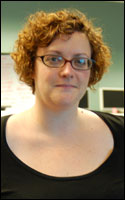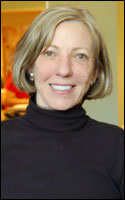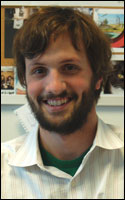Visiting Fellows Bring Expertise to the Newsroom and Classroom
Columbia, Mo. (Oct. 15, 2007) — When a pet monkey bit its second victim in a week, Liz Heitzman, a visiting fellow of the Knight Center for Editing Excellence, had the story on the website of the Columbia Missourian only a few hours later.

As the Missourian’s first-ever immediacy editor, Heitzman, BJ ’99, is helping transform the newspaper, which serves as a working laboratory for Missouri School of Journalism students, from a print-first to an Internet-first publication.
“I think there’s a realization that that’s where our industry is going, and we’re not adequately preparing our students for what they’re going to experience in newsrooms if we’re not training them to write quickly for the Web,” she said.
Heitzman, who spent the past six years as a beat reporter and business editor for the Columbia (Mo.) Daily Tribune, is one of three Missouri Journalism alumni who are back on campus as fellows this semester to help prepare the next generation of graduates for 21st-century journalism careers.
Just down the hall from Heitzman in the bustling newsroom of the Missourian is the office of Jeanne Abbott, BJ ’67, PhD ’88, the second Knight visiting fellow. She leads a team of four students crafting databases of demographic and news information at the Missourian.

“The exciting thing with Jeanne is she’s concentrating on building community knowledge,” said Tom Warhover, chair of the newspaper faculty and executive editor for innovation at the Missourian.
Abbott, who spent the past 13 years at the Des Moines (Iowa) Register, most recently as the assistant managing editor, also leads a team of six feature writers who create the “ie” feature page for the Missourian’s Saturday edition.
“I couldn’t be happier,” Abbott said. “The students are great.”
Both Heitzman and Abbott will be working at the School until May 2008.
One office over from Abbott is Keith Claxton, BJ ’99, the Harte Information Graphics Teaching Fellow. He took a break from his job as a visual journalist at the Chicago Tribune to work a semester at the Journalism School. He said the opportunity to be a leader attracted him to the position.

He currently is teaching an information graphics course two mornings a week. About half of his 15 students are at the graduate level, he said.
“I’m trying to teach them a lot of skills they can take and develop somewhere else,” Claxton said about the course, which is based on Adobe Illustrator but includes lessons on Photoshop, Global Information Systems and Flash. “As a visual journalist, you need to have a broad range of skills. They’re a blank slate for me to draw on.”
Claxton joined the Chicago Tribune in January 2002 for a two-year residency, a competitive program for experienced journalists to work for the major metropolitan newspaper. Of 10 residents hired since 2002, he was one of only two who received a job offer.
“Keith brings a tremendous expertise in graphics, which is more pertinent now than it’s ever been,” Warhover said.
Missouri is one of the few journalism schools in the country offering specific instruction in information graphics, especially in a community newsroom environment and under the supervision of a professional graphics editor.
The School established the Harte fellowship earlier this year, with Claxton as its second fellow. It is funded by the Houston Harte Chair in Journalism, which is currently held by Professor Judy Bolch. The chairs honors Houston Harte, BJ ’15, who bought his first newspaper while still a student at the Missouri School of Journalism. At his death, he was co-founder and chairman of the executive committee of Harte-Hanks Newspapers, Inc., which owned 19 newspapers and one television station.
The Knight Editing Fellowship program launched in 2002 and allows experienced journalists to work with journalism students as an editor at the Columbia Missourian. Jacqui Banaszynski, who holds the Knight Chair in Editing, created the fellowships as an experiment in helping develop newsroom editors. Both the chair and fellowship programs are funded by the John S. and James L. Knight Foundation.
Updated: April 21, 2020